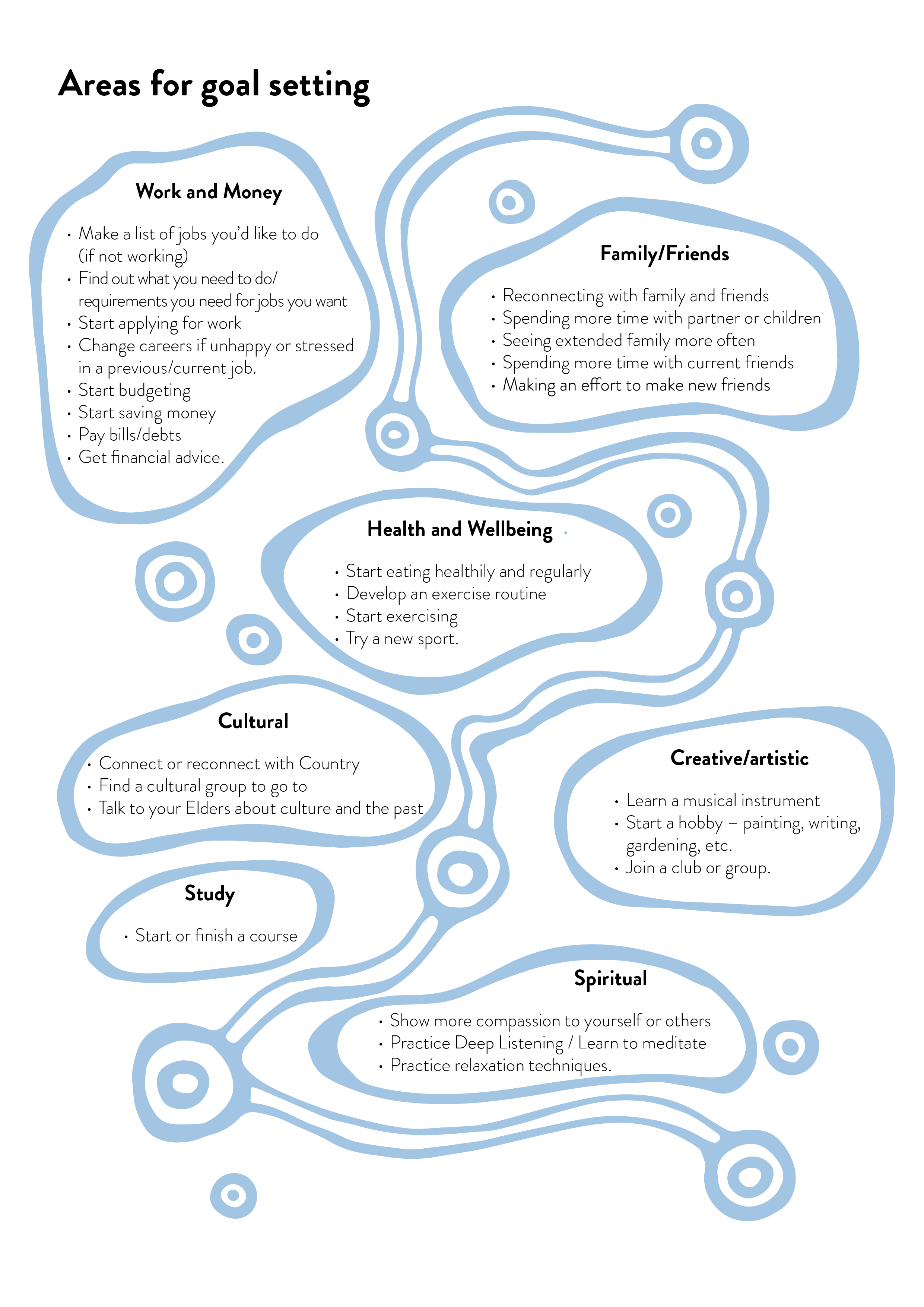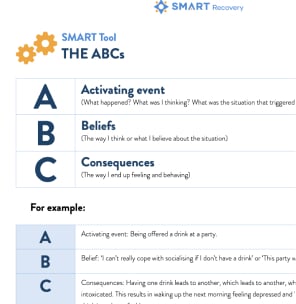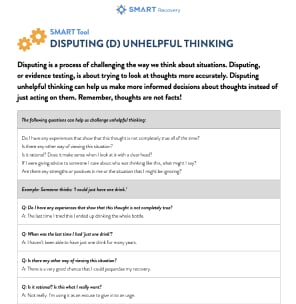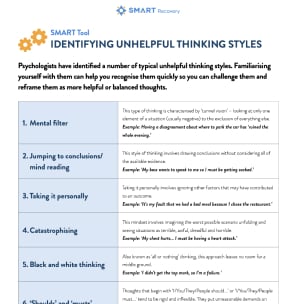Areas for goal setting
Tool Overview
Family/Friends
- Reconnecting with family and friends
- Spending more time with partner or children
- Seeing extended family more often
- Spending more time with current friends
- Making an effort to make new friends
Cultural
- Connect or reconnect with Country
- Find a cultural group to go to
- Talk to your Elders about culture and the past
Spiritual
- Show more compassion to yourself or others
- Practice Deep Listening / Learn to meditate
- Practice relaxation techniques.
Health and Wellbeing
- Start eating healthily and regularly
- Develop an exercise routine
- Start exercising
- Try a new sport.
Work and Money
- Make a list of jobs you’d like to do (if not working)
- Find out what you need to do/ requirements you need for jobs you want
- Start applying for work
- Change careers if unhappy or stressed in a previous / current job.
- Start budgeting
- Start saving money
- Pay bills/debts
- Get financial advice.
Study
- Start or finish a course
- Creative/artistic
- Learn a musical instrument
- Start a hobby - painting, writing, gardening, etc.
- Join a club or group.
When To Use This Tool
Setting smart goals
When setting goals, make sure they are SMART!
SMART ( in this instance) stands for: Specific, Measurable, Achievable, Realistic and Timed.
How To Use This Tool
S Specific
Your goal should be well - defined so that you have a clear direction. For example, setting a goal to exercise more is a bit vague. Know exactly what you need to do. Jogging every morning for 10 minutes is specific.
M Measurable
Goals are measurable when you can gauge your progress and track whether you accomplished your goal in the time set. Using the previous example, you could measure how many mornings a week you went jogging.
A Achievable
Set a goal that you have the means to achieve. If you set a goal of jogging ten kilometers each morning right from the outset but you are very unfit, you may set yourself up to fail. Remember it’s your goal for yourself, not someone else’s goal for you. Make it attainable.
R Realistic
Ensure the goal is within your means by making sure you have the opportunity and resources you need. For example, if you hate jogging, then jogging daily is probably not a realistic goal for you. Walking to improve your fitness might be a more realistic approach.
T Timed
Assign a timeframe to your goal, whether it is short term or long term. Having a deadline can help avoid procrastinating. For example, you may decide to start jogging as of Monday.
Example Scenarios
Example: I want to start exercising to get fit.
SPECIFIC: I will go for a walk every morning for 10 minutes
MEASURABLE: I will walk every day. How and when will I know that walking is making me fit? ( Will I be able to walk three times around the block without getting breathless in four weeks’ time?)
ACHIEVABLE: Do I have the time to walk every day?
REALISTIC: Do I even enjoy walking? Can I walk every day when I often have to work late?
TIMELY: What day am I going to start walking?
Helpful Links
Related Tools
View all- Tool
Lifestyle Audit
When we slow down on a behaviour of concern, it can leave a gaping hole in our lives. Often, we find that we have a lot more free time, which used to be filled with activities related to our old behaviour. Also, we may no longer associate with the same group of friends.
- Tool
Setting SMART Goals
It’s important to make sure goals are SMART: Specific, Measurable, Achievable, Realistic and Timed.
- Tool
Weekly Planner
Once you have set some specific goals and broken them down into smaller, specific steps, the weekly planner can be useful for keeping these goals on track and ensuring that you are taking active steps towards achieving them.
Tool Overview
The ABC Model is a good way of understanding how we can help change our feelings and behaviour by challenging our thinking.
When to Use This Tool
The ABC Model is a good way of understanding how we can help change our feelings and behaviour by challenging our thinking. It helps us uncover beliefs that are not helping us /contributing to the behaviour we are trying to change.
This exercise may be done in the group setting but can also be very useful for participants to look at between meetings.
How To Use This Tool
When working with urges: To analyze a lapse/relapse or to develop coping statements for an anticipated lapse/relapse.
In the event of a lapse, the question to ask is not “What made me do that”, but rather, “How did I talk myself into it?” It is not the urge (A) that causes the lapse (C). It is our beliefs (B); our irrational self-talk.With emotional upset:
The ABC Model can also be used to work with emotional upset or frustrations that may occur at any point in the recovery journey. The ABCs allow us to discover our unhelpful beliefs which contribute to emotional upsets. Disputing helps us eliminate our irrational thinking so we can both feel better and do better. In SMART Recovery we teach that we feel the way we think; it’s not unpleasant events that disturb us, it’s the way we think of them. By changing our thinking, we change how we feel.Identifying and Disputing Unhelpful Thinking.
Disputing is a process of challenging the way we think about situations. It’s about trying to look at thoughts more accurately. Disputing unhelpful thinking can help us make more informed decisions about thoughts instead of just acting on them. Balanced thinking leads to effective new beliefs.



